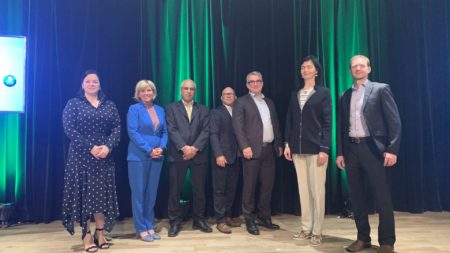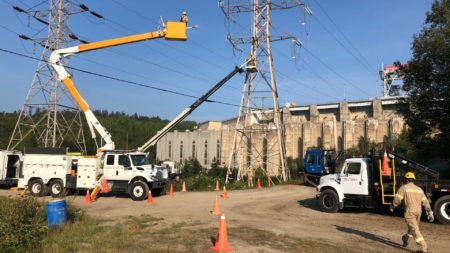INREST, UQAC, and Université Laval combine their expertise to study the Saguenay Fjord ecosystem

INREST, UQAC, and Université Laval combine their expertise to study the Saguenay Fjord ecosystem.
The new Groupe de recherche sur l’écosystème du fjord du Saguenay (GREFS) will advance scientific knowledge and improve understanding of the factors that influence marine habitats, plants and wildlife.
The Northern Institute for Research in Environment and Occupational Health and Safety (INREST) is very proud to announce the creation of GREFS. Bringing together the high-level expertise of teams of researchers and professionals from INREST, Université du Québec à Chicoutimi (UQAC), and Université Laval, the new research group will advance scientific knowledge and improve understanding of the factors that influence the Saguenay Fjord ecosystem.
Coordinated by INREST, GREFS’s work is part of the Enviro-Actions pilot project, which was developed by INREST’s Centre for Industrial Port Expertise (CEIP). This innovative pilot project, combined with two newly created laboratories—UQAC’s Laboratoire de recherche sur l’écosystème du Fjord du Saguenay (Écofjord) and Université Laval’s Laboratoire de recherche sur la biodiversité marine et aquatique (Biome)—will support GREFS in conducting large-scale research projects. The data collected will provide marine managers with a management tool designed to protect ecosystems, better understand the factors that influence the fjord’s plant and wildlife habitat, and find out how these factors interact by linking and analysing them within a comprehensive, independent, and robust scientific framework. This cutting-edge research is made possible by an investment of $5.6 million from local stakeholders and the Government of Quebec.
The in-depth study of the various factors that make up the Saguenay Fjord ecosystem will complement and enhance the existing body of research. It will also promote the continuous improvement of best practices as well as prevention and innovation within the port and shipping industry. For example, within a multidisciplinary framework, GREFS will study various factors that affect the biodiversity and food web of species in the Saguenay Fjord, which will significantly improve current knowledge.
Against this background of improving scientific knowledge, research by GREFS will focus on three main areas:
- The Saguenay Enviro-Actions pilot project, whose purpose is to improve scientific knowledge of marine communities and provide port and industrial zones with the tools and instruments they need to manage their activities in a preventive and proactive manner with regard to their impact on the environment, for instance by issuing Enviro-Alerts
- The study of biodiversity and trophic interactions, i.e., factors relating to the feeding and food web of marine species, combined with the study of species reproduction, recruitment, and migration
- The assessment and identification of environmental stressors and their impact on marine plants and wildlife
GREFS and the Enviro-Actions project are supported and made possible by the Port of Saguenay, Rio Tinto, Promotion Saguenay, and the Government of Quebec through the Ministère des transports as part of the Advantage St. Lawrence strategy.
Visit https://inrest.ca/en/environment/#enviro-actions for more information on the Enviro-Actions project.
“According to UNESCO, sustainable development requires a solid scientific understanding of the marine environment’s response to anthropogenic pressures combined with proper management. Ocean observation and research are also essential for predicting the consequences of climate change, designing mitigation measures, and supporting adaptation. The creation of GREFS positions the scientific and financial partners among the world leaders in the preservation of marine environments. It also reflects the guiding principles of the Quebec government’s Advantage St. Lawrence maritime vision, the objectives of Environment and Climate Change Canada’s (ECCC) St. Lawrence action plan implemented through the Canada-Quebec Agreement, as well as the recommendations of the United Nations as part of a responsible and sustainable approach.”
-Julie Carrière Ph. D.
Executive Director, INREST/CEIP
“Our research will focus on the fish in the Saguenay Fjord, their reproduction, feeding, growth and survival, with an emphasis on forage fish, such as smelt and capelin, which are, in a way, the “pantry” for marine mammals, birds and fish-eating fish.”
-Pascal Sirois Ph. D.
Laboratoire ÉcoFjord, UQAC“Though the Saguenay Fjord is an exceptional ecosystem with a unique and strategic environmental, economic and social position, we know very little about its biodiversity, its habitats and the effects of human activities on its health. The first studies on the invertebrates of the Fjord were carried out in 1958 by Mgr. Drainville and then again in the early 1970s. This resulted in the identification and listing of 229 species living on the Saguenay seabed. Apart from a few projects conducted in the 1990s, particularly after the flood of 1996, not much is known about the biodiversity of invertebrates, even though they represent 99 percent of the marine fauna biodiversity.”
-Philippe Archambault Ph. D.
Laboratoire Biome, Université Laval“Advancing scientific knowledge and understanding the factors that influence the Saguenay Fjord ecosystem are essential when it comes to responsibly and sustainably developing our environment and peacefully coexisting in it. The Port of Saguenay is proud to act, in close collaboration with credible and important partners, as a practical and forward-looking leader to promote the continuous improvement of our practices and the proactive management of our activities.”
-Carl Laberge
President and Chief Executive Officer
Port of Saguenay
After several years of discussions,” says Catherine Munger, General Manager, Environment and Sustainability, Rio Tinto Aluminium, “we are very proud to have created GREFS, whose work will help better document and understand our unique and precious environment. This knowledge will also make it possible for Rio Tinto to keep its shipping operations running in a way that is safe for the Saguenay ecosystem. We always strive to protect the environment in our host communities and are pleased to invest $2.67 million to support scientific research.”-
Catherine Munger, Ph.D.
General Manager, Environment and Sustainability
Quebec Plan
“The Saguenay Fjord is at the core of our city’s economic development and tourism. It is part of our DNA and provides us with a unique gateway to the world. Promotion Saguenay is proud to be making a tangible contribution to the advancement of scientific knowledge on the fjord and its habitats through its involvement with GREFS, alongside reputable partners and researchers. This knowledge is the key to ensuring innovative, sustainable and responsible growth for Saguenay and our region and to laying a solid foundation for the future.”
-Priscilla Nemey
Executive Vice-President
Promotion Saguenay


